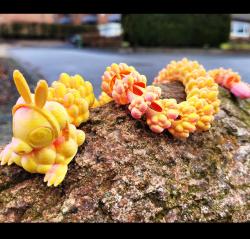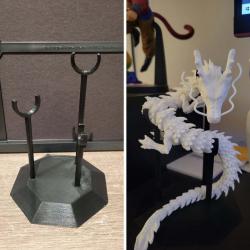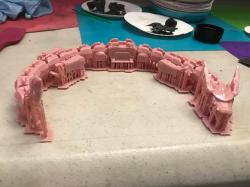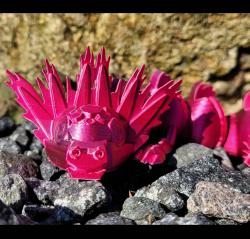 Easterbuns articulating eggtastic dragon
Easterbuns articulating eggtastic dragon Sprinkles articulating candy dragon
Sprinkles articulating candy dragon Stand for Articulating Dragon
Stand for Articulating Dragon Articulating Thunder Dragon
Articulating Thunder Dragon Set of dragon models 3D print model
Set of dragon models 3D print model Axel Lot articulating axolotl dragon
Axel Lot articulating axolotl dragonArticulated Dragon Models
Imperial Dragon by Flexi Factory: Designed by Dan Sopala of Flexi Factory, this model stands out for its ability to take on a graceful position, thanks to the unique design of fused joints. However, printing this model can be challenging. It requires perfect bed adhesion, effective cooling to handle the 80 curved spikes on the dragon’s back, and careful settings adjustment to prevent warping and layer shifting.
Themed Dragon Collection by Dragons Den: This collection offers a variety of themed dragons, including those for Halloween and Christmas. Printing these models can involve working with dual-color materials, which adds to the complexity but results in visually stunning pieces.
Seasonal Articulated Dragons: Certain models like the Flexy Zombie Dragon by Toonz Factory are perfect for seasonal printing, such as during Halloween. These models can be scaled and printed with standard settings, offering flexibility in terms of size and complexity.
3D Printing Techniques and Tips
- Bed Adhesion: This is crucial for a successful print. Models with many joins, like Flexi Dragon by McGyBeer, require strong adhesion to prevent failures. Using rafts can help secure bed adhesion on multiple joints.
- Rafts and Supports: Depending on the model, using rafts can aid in maintaining the structure during printing. Supports might be necessary for models with intricate designs or overhangs, like the Sea Serpent by 7Fish.
- Bridging and Speed: Good bridging is essential for articulated parts to avoid sagging and breakage. Printing slower, especially the first layer, can improve quality and adhesion.
- Cooling and Warping: Proper cooling is vital to prevent warping, especially for models with protruding elements like scales or horns. If warping occurs, the nozzle might catch these parts, leading to print failure.
Popular Articulated Dragon Models
- Lung Oriental Articulated Dragon by 7Fish: This model stands out for its beautiful design, free and open-source nature, and compatibility with both PLA and ABS filaments.
- Seven the Articulated Dragon by 7Fish: Known for its challenging build due to the tight tolerances in its joints. It’s a complex model that requires precision and patience.
- Articulated Crystal Dragon by Castro3D: A unique design that simulates a dragon made of crystals. It looks particularly stunning when printed in different colors or clear filament.
Frequently Asked Questions (FAQ)
Q: What are the best materials for printing articulated dragons? A: PLA and ABS filaments are commonly recommended. The choice depends on the specific requirements of the model and your printer capabilities.
Q: How can I improve bed adhesion for complex models? A: Using a raft can significantly improve bed adhesion. Additionally, materials like Magigoo can aid in securing the model to the bed during printing.
Q: Are articulated dragon models suitable for beginners in 3D printing? A: While some models are more beginner-friendly, others can be quite challenging due to their complexity and the precision required in printing articulated joints.
Q: Can I scale these models? A: Yes, many articulated dragon models can be scaled. However, scaling down might increase the difficulty in printing due to smaller, more intricate parts.
In summary, creating articulated dragon 3D models is a rewarding and intricate process that combines art, design, and technical skill. The key to success lies in understanding the specific requirements of each model, from bed adhesion and supports to cooling and printing speed. With patience and practice, these models can bring the mythical beauty of dragons into the real world.
